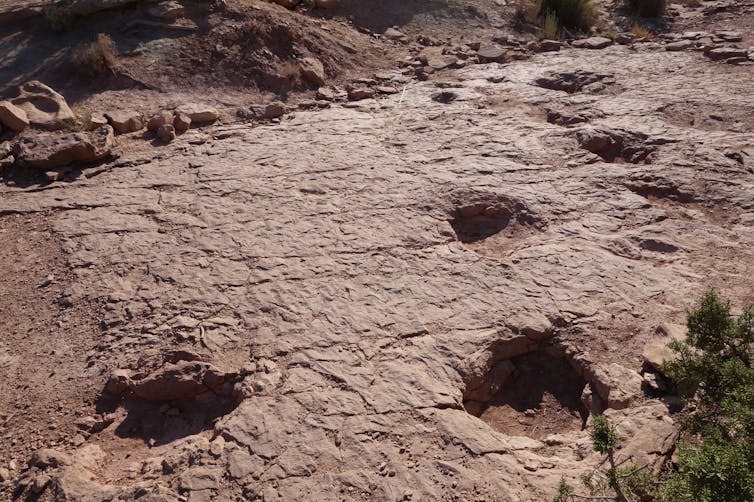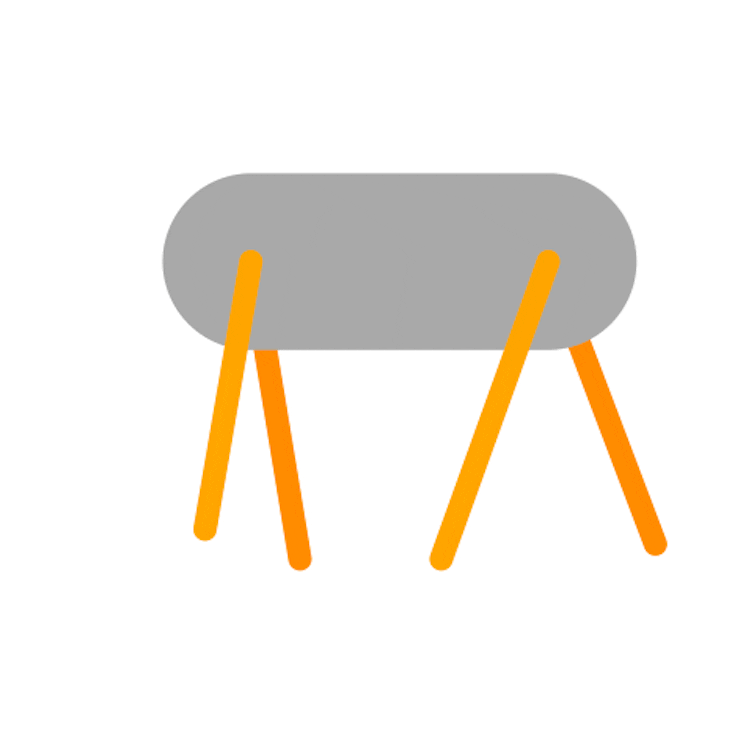Kostiantyn Ivanyshen/shutterstock
While our knowledge of dinosaurs and other extinct animals has dramatically increased during the last couple of decades, their gaits – the order and timing of how animals move their legs – have remained a blind spot.
We are particularly interested in the giant long-necked sauropod dinosaurs, which include the largest animals that walked the earth, including such famous species as Diplodocus, Brontosaurus and Brachiosaurus. How did these giants move? What role did efficiency and stability play during their locomotion?
Those questions have not been easy to answer. The problem is that skeletons are the remains of deceased animals and don’t preserve motion. So reconstructing gaits based on fossilised bones can only indirectly provide clues, and are far from conclusive.
Investigating gait from tracks
As it happens, there is another type of fossil that records the activity of an animal when it was alive, and they are known as fossil trackways. But until now, extracting gait information about extinct dinosaurs from these footprints has proved difficult.
A 2016 study demonstrated that two animals of different sizes and using different gaits could produce identical track patterns. This means that to identify gait from the tracks we would need to know the trunk length of the animal (distance from hip to shoulder). Unfortunately it could not be accurately estimated from tracks so we were left with too many unknowns.
Read more:
A social species? Newly discovered fossils show early dinosaurs lived in herds
But one important aspect had not yet been taken into account – the variation along a set of tracks caused by small changes in speed. In our new study, we used this variation to present a new method to use tracks to work out which gait had been used.
Obviously the trunk length of an animal cannot change as it walks – so, we can therefore measure the trunk length from the tracks at many different points along it, while each time assuming a different gait. The gait which produces the most consistent trunk length along the tracks can be assumed to be the correct one.

Jens Lallensack, Author provided
It all made perfect mathematical sense. All we needed to do was make sure our new method worked when applied to the tracks of modern animals, including three dogs, two horses and an elephant. In each case, the method produced gratifyingly accurate estimates of the animals’ gaits.
How dinosaurs moved
So, for the first time we had developed a way to study gaits of the past. We applied the method to three fossilised tracks of giant sauropods from the Early Cretaceous period of Arkansas, in the US – the largest of which had footprint lengths of 85cm.
The results were really surprising. Previous studies suggested that sauropods might have walked in a pace gait (similar to a camel) or a singlefoot walk (similar to a slow moving horse). But we expected that sauropod gaits would resemble those of elephants, as they are the largest land animals alive today.
Elephants employ lateral couplets gaits – they tend to move the fore and hind limb of the same body-side together, like in the animation below. They therefore fall in between the pace gait (the extreme of a lateral couplets gait where hind and fore limb of one body side move exactly in sync) and the singlefoot gait (where the time lag between all limb movements is exactly equal).

Jens Lallensack, Author provided
Our new method, however, indicates that all three sauropods we studied via tracks had walked in a diagonal couplets gait, where they move the limbs of the opposite body-side together. The extreme in this gait is called a trot (the diagonal pair moves exactly in sync). So, to our surprise sauropods did the opposite of what we see in elephants.
How can this difference be explained? Well, Cretaceous sauropods do differ from elephants in one important aspect – they are much wider. The tracks we studied are especially broad (or wide-gauged), with left and right tracks spaced well apart from each other.
Elephants, in contrast, set one foot almost in front of the other, forming a narrow path. This has consequences for the gait. An elephant only needs to shift its body mass slightly to one side in order to swing both legs of the other side forward together. A wide-gauged sauropod, however, would have needed to drastically sway its body towards one side to achieve the same.
Read more:
Dinosaur embryo discovery: rare fossil suggests dinosaurs had similar pre-hatching posture to modern birds
So, the diagonal couplets gait assured that the sauropods always had at least one foot on the ground on either side of the body, avoiding such swaying from left to right. Stability therefore seems to have played a major role in how the largest creatures ever to have roamed this planet walked.
Interestingly, almost all large modern mammals show very narrow tracks, in combination with lateral couplets gaits. But the wide-tracked hippopotamus, in contrast, uses a diagonal couplets gait (moving limbs of the opposite body side together) just as we estimated for wide-tracked sauropods. So while it’s easy to assume that because elephants are the largest animals on land today, large land animals of the past must have moved like them, it appears that this was not the case.
![]()
Peter Falkingham works for Liverpool John Moores University, UK.
Jens N. Lallensack receives funding from the German science foundation











